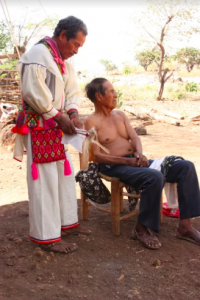© 2016 I.S. Konrad
2016 – №1 (11)
 Keywords: shamanism, treatment, illness, Mexico, the Huichol
Keywords: shamanism, treatment, illness, Mexico, the Huichol
Abstract: The article, based on the author’s fieldwork, examines key ideas about illness and shamanic treatment among the Huichol people of Western Mexico. Among the questions tackled are the status of the shaman in Huichol communities and the process of becoming a shaman. The article also contains the description and an attempt at the classification of shamanic methods of diagnosis and treatment. Particular attention is paid to the Huichol understanding of “illness”, to the forms that it takes and to the ways in which its origins are explained.
The Huichol are one of the native peoples of Mexico, the majority of whom currently reside in the Western states of Nayarit, Jalisco and Durango. The remote and inaccessible nature of this location (which is for the most part shielded by the Madre Occidental mountain range) has allowed the Huichol to preserve their traditional culture to this day. The everyday practices, religious beliefs, arts and crafts are still in evidence.
In March 2016 researchers from the Moscow Pedagogical State University and LycéeNo. 1153, named afterV. I. Vernadsky, visited one of the Huichol villages, Potrero de la Palmita, in the state of Nayarit. The aim of the expedition was to document the contemporary state of traditional culture in this community.
One of the key themes that we addressed was the distinctive nature of shamanic medicine among the Huichol: How do the Huichol understand the causes of illness? How do they describe its forms or symptoms? What actions does the shaman take to relieve the sick of their predicament?
To answer these questions we studied Huichol beliefs and in particular the role of the shaman. Conversations with our informants (who ranged from 10 to 80 years of age) revealed that in the remote territories of contemporary Mexico primordial animistic beliefs are still very much alive. Ancient customs associated with the changing of seasons are still being observed. Sacred sites, especially Wirikuta, continue to serve as destinations of compulsory pilgrimage. Plants, such as corn or the peyote cactus, and animals, such as the deer or the eagle, are still revered cultural symbols.

The study of Huichol medicine has allowed us to draw the following key conclusions. Firstly, the shaman still enjoys high status in the Huichol community of Potrero de la Palmita. He is trusted both in the diagnosis of illnesses and in the choice ofmethods of treatment. Secondly, descriptions of causes of illness reflect both traditional value systems (e.g. the obligation to visit sacred sites or follow religious injunctions) and the traditional worldview (e.g. animistic beliefs). Thirdly, the process of healing is built on participatory relationships and sympathetic magic.
Becoming a shaman can be something that the community recognizes in a person sometimes even from birth, but it can also be an individual’s own personal choice. Whether one becomes a “good” or an “evil” shaman will depend on one’s personal qualities, or rather on one’s skill in followingall the rules and precepts while in training by the higher forces.
References
Istochniki po ehtnicheskoj istorii aborigennogo naseleniya Ameriki (2012) [Sources on the ethnic history of the indigenous population of America] EH.G. Aleksandrenkov, A.A. Istomin (eds.), M.: IEA RAN, 2012. – 270 p.
Sokolova, O.V. (2010) Tekstil’nye izdeliya uichol’ (zapadnaya Meksika) v sobranii MAEH [Textiles in the huichol (Western Mexico) in the Peter the Great Museum of Anthropology and Ethnography (the Kunstkamera) collection], Sbornik muzeya Antropologii i ehtnografii [The Collection of the Museum of Anthropology and Ethnography, St. Petersburg] SPb., T. LVI, pp. 162–175.
Sokolova, O.V. (2012) Obraz olenya v religioznyh predstavleniyah indejcev uichol’ (po materialam kollekcij MAEH RAN) [The Image of the deer in the religious beliefs of the huichol Indians (according to the materials of the Peter the Great Museum of Anthropology and Ethnography (the Kunstkamera) collections], Radlovskie chteniya [Radlowski reading], SPb., pp. 246–251.
Preuss, K.Th. (1908) Etnographische Ergebnisse einer Reise in die mexikanische Serra Madre [Ethnographic results of the journey to Mexican Sierra Madre], Zeitschrift für Ethnologie [The Journal of Ethnology], Heft 4. Berlin, S. 584–604.